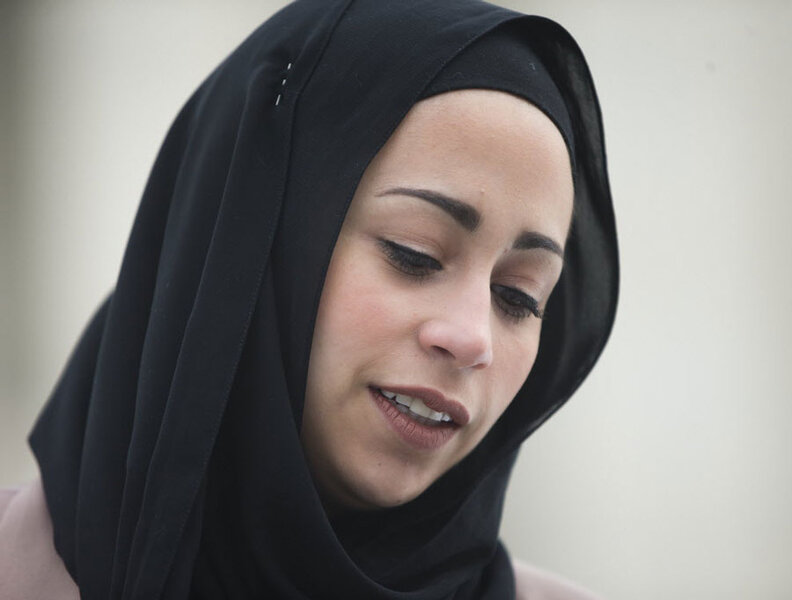Abercrombie headscarf case: Supreme Court considers religious accommodation
Loading...
| Washington
The US Supreme Court grappled on Wednesday with the issue of whether the clothing retailer Abercrombie & Fitch discriminated against a Muslim teen when it refused to hire her because her headscarf clashed with the company’s strict dress code.
Abercrombie rejected an application from Samantha Elauf, then 17, after concluding that her black headscarf would violate the company’s policy prohibiting employees from wearing caps and from wearing black clothing.
During the job interview, an assistant manager did not ask Ms. Elauf about her headscarf, but assumed Elauf was Muslim. For her part, Elauf did not raise the issue of the headscarf and she never asked if Abercrombie might offer a religious accommodation.
The Equal Employment Opportunity Commission (EEOC) sued Abercrombie on Elauf’s behalf, charging religious discrimination. A federal judge ruled for the teen, but an appeals court panel sided with Abercrombie.
The appeals court said that Abercrombie could not be held liable for failing to provide a religious accommodation if the company had never been given explicit notice by the job applicant of a clash between workplace rules and a religious practice.
At issue before the high court is who has the burden of raising the issue of a potential religious accommodation, the employer or the employee/job applicant?
Deputy Solicitor General Ian Gershengorn told the justices it is up to the employer to discuss any potential religious issues and take action to resolve them.
He said Abercrombie could have announced that the company doesn’t allow salesclerks to wear headscarves. Then it would be up to the applicant to request a religious accommodation, he said. In that case, both parties would be on notice.
But Mr. Gershengorn said that once a company “understands,” “suspects,” or “correctly believes” that a job applicant may need a religious accommodation from neutral work rules, that applicant must be offered an accommodation.
Chief Justice John Roberts and Justices Antonin Scalia and Anthony Kennedy questioned what level of certainty of a potential religious clash would trigger the need for accommodation.
“Your position ... is that he must ‘understand.’ You stay away from the word ‘know,’ ” Justice Kennedy said, noting that he found the position confusing.
“We think there is sufficient knowledge, notice, when somebody understands ... assumes that a practice is religious and then acts upon it, that that is sufficient,” Gershengorn replied.
The deputy solicitor general added that if an employer had some doubt about a possible clash between workplace rules and a job applicant’s religious practices, there should be a dialogue between employer and the person over the issue.
No such dialogue took place in the Abercrombie-Elauf case.
Justice Scalia responded by repeating Abercrombie’s argument that it should be up to the applicant/employee to raise the issue of religious accommodation.
“You could avoid those hard questions, whether it’s ‘understand,’ ‘believe,’ ‘suspect,’ by adopting the rule the court of appeals adopted here,” Scalia said. “If you want to sue me for denying you a job for a religious reason, the burden is on you to say, ‘I’m wearing a headscarf for a religious reason.’ ”
Abercrombie’s lawyer, Shay Dvoretzky, said that the approach favored by the EEOC and the Obama administration would be “unadministrable.”
The government has not identified what level of certainty is required for a “belief” or “suspicion” that an individual might be religious and entitled to an accommodation, he said.
“The question before the court is, what level of knowledge does the employer have to have before the duty to accommodate is triggered,” Mr. Dvoretzky said. “For 40 years, the EEOC’s own guidance has put the burden to initiate the conversation on the employee because only the employee knows.”
Justice Ruth Bader Ginsburg pushed back. She said Elauf had no reason to think that the company would not accept her wearing a headscarf. Justice Ginsburg said that Abercrombie had not given her notice of the company’s dress code.
Dvoretzky said Elauf had asked a friend about the company and the dress requirements.
A possible turning point in the case came midway through Dvoretzky’s argument.
Justice Samuel Alito mentioned the company’s prohibition on employees wearing black. The justice asked if a job applicant arrived to the interview in a black blouse whether Abercrombie would refuse to hire that person on the assumption that she would wear black every day at work.
“I don’t think Abercrombie needs to make that assumption about what the person will do later in order to make a judgment based on the person’s appearance at the interview,” Dvoretzky said.
A few minutes later, Justice Alito expanded on his prior question. He wondered why, in Elauf’s case, she wasn’t hired.
“There would be no reason for not hiring [Elauf] unless you assumed that she was going to wear a scarf every day,” Alito said. “Just because she wore a scarf on that one day wouldn’t mean that she necessarily was going to wear it every day."
“Maybe she’s just having a bad hair day,” he suggested. “Would you reject her for that? No.”
Alito added: “The reason that she was rejected was because you assumed she was going to do this every day, and the only reason why she would do it every day is because she had a religious reason.”
Dvorestzky denied the suggestion that Abercrombie didn’t hire Elauf because she wore a religious headscarf.
“Abercrombie might well not have hired anybody who walked in wearing any head cover,” he said.
The case is EEOC v. Abercrombie & Fitch Stores Inc. (14-86). A decision is expected by late June.





